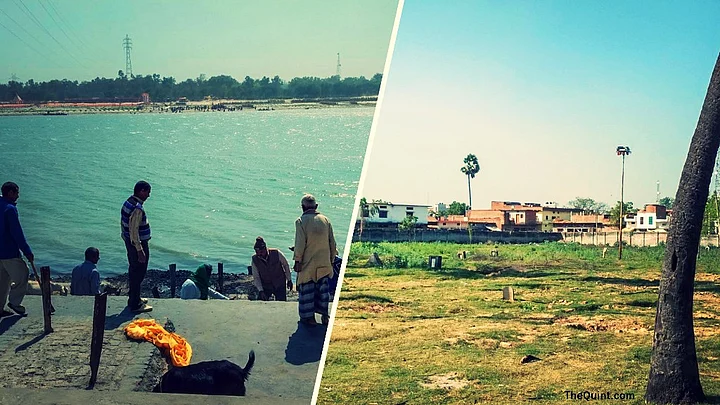It took less than a minute for the ghee-splattered pyre to light up. Before long, helped by the winds blowing in over the blue waters of the Ghaghra (the mythical Sarayu) river, the pyre was fully aflame, and the wood crackled, spewing flakes of ash and slowly consuming the lifeless body inside.
The wind-swept loose dirt mixed with the acrid smoke of burning human flesh, stinging the nostrils and the eyes.
Efficient Shamshaan, Quiet Kabristan
Four pyres burned on the north bank of the Ghaghra river that snakes in from the north and divides the Mau and Gorakhpur districts. The other ten had cooled, leaving behind a grisly mixture of charred wood and splints of human bones.
Above the north bank, on the left side of the Muktipath burning ghat, stands a modern electric crematorium that lies idle because the rural folks of Barhalganj and other places of Gorakhpur prefer performing the last rites here because of the pyres’ proximity to the river.
The Muktipath complex is a huge concrete sprawl, and by rural standards, quite spic-and-span. A sea of humanity mills about the site. Small stores displaying gamchhas, singlets and sundry items associated with cremation rituals, and stalls selling tea, ground nuts and cheap sweets, do brisk business. A gigantic idol of Shiva looms over the crematorium, as if watching over the mortal humans’ last journey.
Prime Minister Narendra Modi would have been pleased by the efficiency with which last rites are performed at Muktipath, which is by no means a small “shamshaan”. But what would have been his reaction to a mere two-acre-wide burial ground for the Muslims of Barhalganj in Chillupur Assembly constituency?
The burial ground lies bang in the middle of the crowded Naushahra Mohalla, barely 500 metres from Muktipath. A conjoined mosque-and-temple is on one side of the walled burial ground. The gates to the “kabristan” were locked this afternoon. But the caretaker of the mosque, 66-year-old Iqbal Ahmed, who keeps a spare key, gladly opened the humble gates for us.
At a few spots, fresh earth had been dug up, forming small mounds. Not a human moved about in the ground, dotted with tombstones and lined by tall coconut trees. “Not very far away, in Tiwaripur, is a smaller “kabristan”, portions of which have been grabbed by land sharks,” informed Jamal Ahmed, who is a member of the Naushahra Mohalla mosque managing committee.
In Poll-Bound UP, Digging up the Skeletons
“The Muslims of Naushahra Mohalla are not shocked by Modi’s ‘samshaanghat-kabristan’ comparison. And we dismissed it with the contempt it deserves. He is the prime minister of a country the size of India and we expected a little more grace and decency from a man of his stature,” Iqbal Ahmed said, his long, grey beard blowing in the breeze.
But Jamal was harsher. “Yes, yes, we know that it has always been the BJP’s ploy to drive a wedge between Hindus and Muslims, especially before elections. We are fully aware of what happened in Muzaffarnagar in 2013. The riots there helped consolidate Hindu votes,” Jamal said as he angrily spat out a thick, crimson jet of paan juice.
As he turned and adjusted his steel-rimmed spectacled to speak about the 2002 Gujarat riots, the wizened Iqbal Ahmed held his right wrist, stopping him from “sharing other unpleasant events of the past”. Standing by the gates of the “kabristan”, Iqbal reasoned: “Gadhe huye murde nahin ukhadne chahiyye.”
‘Cycle Chalaayein Ya Kamal Khilaayein?’
Back at the Muktipath crematorium, a crowd of Yadavs who had driven 12 kms from Bairiyakhas village in Gorakhpur to accompany a community member who had passed away, sat on a cemented platform, watching the grim proceedings. Pointing a finger across the river, to its south bank, Phoolchand Yadav said: “Woh dekhiye, ek aur shamshaanghat. Woh jagah Mau ziley mein padhta hai.”
Close to the cremation ground on the south bank, which is called Muktidham, is a white-domed mosque. There, hundreds of people had gathered to take part in the Mateshwari Pariwar Mahayagna, which is organised every two years.
“Iss bar cycle ko jeetna chahiyye,” Phoolchand said, the hint of a smile in one corner of his pudgy lips betraying his preference for the Samajwadi Party. But a powerfully built Pintu Tiwari, who does “thekedaari”, insists that “BJP satta mein aayegi.” He admits that “BJP ne kuchh kaam nahin kiya hai,” but “party ki soch achhi hai.” But Rajesh Yadav, a tractor driver, believes that “BJP ne kendra mein kaam achha kiya hai.”
Close to the cremation ground is the Acharya Swargiya Pandit Suresh Dutt Tripathi Bal Vidya Mandir, a primary school. Outside its iron gate, siblings Sajida (eight-year-old) and Sahir (six-year-old) pass small chanachur sachets to a bunch of cacophonic school kids through gaps in the gate.
Some of the children make spot payments in coins while others take the packets on the promise of paying “tomorrow”. Behind the school stands the green-domed mazaar of one Pir Syed Baba.
The plumes of loose dirt and sand, swept up by the gale, drive the kids back to their classrooms, leaving the disappointed siblings to pack up their ware and head home.
The modernised cremation ghat came up 16 years ago when Muktighat was shifted from its original location 2 kms upstream the Ghaghra. More recently, the beautification drive involved razing an East India Company structure – locally called the Afeem Bangla – and putting up a green space in its place.
Ravaged by time, the ruined ‘Afeem Bangla’, a “haunted” structure in the eyes of locals, was among a few other buildings of the East India Company whose merchants forcefully employed farmers to cultivate opium in these parts of Uttar Pradesh back in the early years of the 19th century.
(At The Quint, we question everything. Play an active role in shaping our journalism by becoming a member today.)
